by Thomas Kamrath
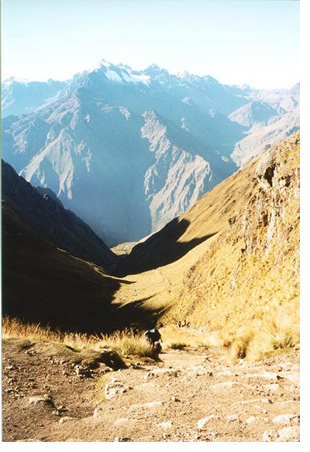 It’s four-thirty in the morning of day five. The porters have just come to our tent to wake us. No coffee or tea this morning. We need to get moving to reach the Sun Gate (Intipunku) by 7:00 a.m. or we will miss sunrise over Machu Picchu.
It’s four-thirty in the morning of day five. The porters have just come to our tent to wake us. No coffee or tea this morning. We need to get moving to reach the Sun Gate (Intipunku) by 7:00 a.m. or we will miss sunrise over Machu Picchu.
It is pitch black. I can feel the heavy humid fog left behind by last nights rain. This is why the tour dossier listed “flashlight.” Unfortunately my brand new one lasted only one pre-trip check.
Fortunately Dave, my traveling buddy, had a spare key chain light?giving me a shadowed view of the ground in front of me. The majority of our hiking party of nine must have missed the memo as we had only four flashlights.
An hour after wake-up call, we are on the trail. It’s dark, foggy, wet, and the rocks are slippery. We alternate places between the have and have-nots (flashlights).
As we march, the only voices heard are from the haves. “Step up, step down, watch out for the rock on your left.” We are probably better off not knowing there is a two hundred foot drop-off inches from our feet.
We reach Intipunku with fifteen minutes to spare. The view at sunrise is not what we were told in the travel brochures. Three feet in front of our face is a white substance called fog. Today was not meant to be and I recite my often used travel line, “it’s all part of the experience.”
As we inch our way down toward the Machu Picchu ruins, my anticipation is bursting. “When will the fog lift?” Slowly, as if someone is cranking up a curtain, Huayna Picchu begins to appear. First there are fleeting glimpses, then finally, there it is in its full splendor.
When I envisioned going to Machu Picchu, I always thought of mysterious ruins and the famous picture postcard of Machu Picchu with Huayna Picchu in the background.
But, there is more to this man/nature wonder of the world. It is the adventure of getting there. I knew if I wanted to experience the feel of the Inca culture and the energy of the Sacred Valley, I needed to do “the hike.”
“The hike” is the Inca Trail. Depending on your starting point, it is twenty-five to thirty-three miles of semi arid desert, breathless mountain passes, and stunning tropical cloud forest.
Our guide Mauro keeps telling us “No worries, the hike is 90% mental and only 10% physical.” I am not convinced that the physical percent is correct, but there is definitely a continuous adrenaline rush as we got closer to Machu Picchu.
By getting myself into pretty good shape, I am able to enjoy the beauty of the hike and not worry as much about aching muscles and lungs.
The first day of the Inca Trail hike was almost as eventful as the final day. We had to start the hike a half day early, due to a planned national strike. The transportation systems were about to be shutdown and quick thinking by Mauro helped us get out of Cuzco while we still could.
It got a little nerve-racking as we were leaving Cuzco. The van driver had to perform a 180 degree turn to avoid a group of protesters heading our way.
The early start gave us four nights on the trail, but also allowed us to reduce our miles per day. The first and second day we were on the west side of the Andes.
The terrain was semi-arid to tundra. We had radiant blue skies and fantastic views of Peru’s 20,000 foot peaks. Our second night was the roughest.
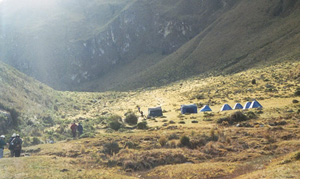 After hiking ten miles, we camped at 12,600 feet. A combination of dehydration and temperatures dropping into the twenties gave everyone a restless night of sleep.
After hiking ten miles, we camped at 12,600 feet. A combination of dehydration and temperatures dropping into the twenties gave everyone a restless night of sleep.
The next morning was the most challenging part of the hike (but also the most satisfying), Dead Woman’s Pass. At 13,700 feet, this pass the highest point of the trail.
It helped to be fresh and starting at 12,600 feet. We made it to the pass in about an hour and waited for our fellow hikers to arrive (the ones who were working on the 90% mental).
After Dead Woman’s Pass the terrain begins changing to cloud forest. It is also the fringe of the Amazon and starts to have that jungle feel. On this part of the trail the foliage has to be cut back every three months or it would engulf the trail. No wonder it took until 1911 for Hiram Bingham “re-discover” Machu Picchu.
The workmanship of the original Inca Trail (built over five hundred years ago) was extraordinary. The majority of the trail is original and in good shape.
Occasionally we hit some rough spots where the trail was deteriorating. This always coincided with parts of the trail that had been rebuilt. The modern parts of the trail were always in worse shape than the original.
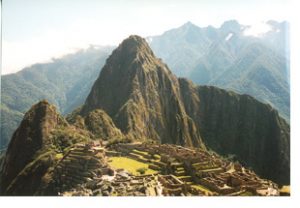 It has been said that the seven separate mountain valleys leading into Machu Picchu foster an elevated energy level.
It has been said that the seven separate mountain valleys leading into Machu Picchu foster an elevated energy level.
I am not sure if it was that or the accomplishment of finishing the hike and achieving a dream that had been with me since 10th grade geography, but there was definitely an energy surge in full swing while touring the ruins.
Back in Cuzco, following the hike, our group stuck together after the official tour was finished.
Celebrating our successful hike at a local restaurant, I was the only one to brave ordering the national delicacy, guinea pig. They serve it with the head and feet intact so one would not think they were being misled and served something else, (like cat).
It didn’t taste like chicken or duck as I had been told. It was more of a wild tangy flavor – probably closer in taste to the woodchucks that burro under my deck back home (not that I know what they taste like)!
About the author:
This week Traveling Tales welcomes freelance travel writer Thomas Kamrath, who makes his home in Madison, Wisconsin, USA.
Photos by Thomas Kamrath:
1: Atop Dead Woman Pass.
2: Our highest camp at 12,600 ft (3840 m),
3: Our goal – Machu Picchu with Huayna Picchu in backgrond.
Tour Information:
There are many tour groups that plan Inca trail trips. They range from all inclusive to local guided tours. A good cross section of tours would be:
Gap tours, www.gapadventures.com, 1-800-692-5495,
Wilderness Travel, www.wildernesstravel.com, 1-800-368-2794,
Mountain Travel Sobek, www.mtsobek.com, 1-888-687-6235.
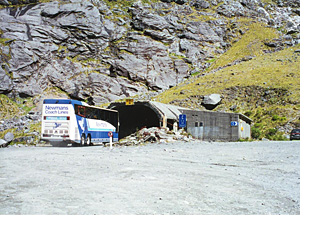 The sun had set. It was a moonless night, but the intensity of the stars lit up the sky. It looked like a thousand candles squeezed onto a dark chocolate cake. There was no Big Dipper but the Southern Cross filled in admirably. I was in New Zealand’s Fiordland national park, the southern brother of Norway’s fjords, anchored for the night on Milford Sound.
The sun had set. It was a moonless night, but the intensity of the stars lit up the sky. It looked like a thousand candles squeezed onto a dark chocolate cake. There was no Big Dipper but the Southern Cross filled in admirably. I was in New Zealand’s Fiordland national park, the southern brother of Norway’s fjords, anchored for the night on Milford Sound.
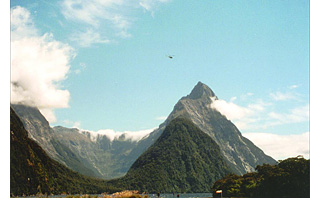 Arriving at Milford Sound, the first thing I saw was Mitre Peak towering 5,500 feet (1676m) above the sound. It is the world’s highest peak rising directly out of the water.
Arriving at Milford Sound, the first thing I saw was Mitre Peak towering 5,500 feet (1676m) above the sound. It is the world’s highest peak rising directly out of the water.